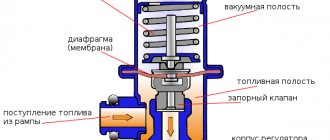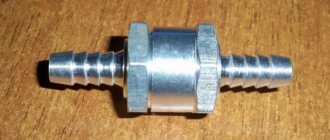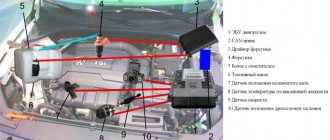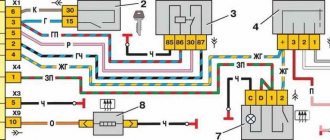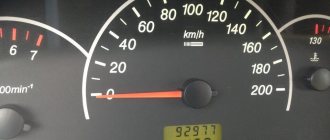Greetings to the owners of domestic VAZ "ten", as well as to all those who are now reading these lines! In previous issues we talked a lot about foreign cars (Mitsubishi Lancer 9, Renault Duster, VW Polo sedan, etc.), it’s time to devote a couple of pages to those who support the Russian automobile industry. So, we will talk about the topic: what to do if the fuel consumption of the VAZ 2110 has increased, as well as what it should actually be with proper operation.
High gas consumption of VAZ 2110 and all about it
Today, high gas consumption of the VAZ 2110 is a fairly common problem among car owners. High gasoline consumption for a VAZ 2110 can occur for various reasons. However, before you “treat” the car, it is worth finding what is causing the car to function poorly. Indeed, if a car begins to overuse fuel, then this is bad, as undesirable consequences may appear.
conclusions
- Check actual costs with the on-board computer readings. Make a full refuel, record the mileage data.
- Regular diagnostics of malfunctions will promptly identify the cause of the defect that affects increased gasoline consumption.
- Don’t delay, don’t save, because the consequences will definitely lead to serious, expensive repairs.
–> VAZ Masters / Engine power system / Fuel consumption
VAZ 2110
Disadvantages of the VAZ 2110 car
VAZ 2110 high fuel consumption
VAZ 2110 is a sedan with four doors. The peculiarity of the car is its original and unusual design. The production of this brand was first discussed in 1996. It is still being created today. The car is in high demand due to the fact that:
- They are made of quality materials;
- They can overcome any obstacles;
- They cope with any trails and conditions.
Note: By the way, they say that the amount of fuel it consumes also depends on the roads on which the VAZ 2110 travels. Therefore, sometimes it is impossible to deal with the problem of high gasoline consumption of the VAZ 2110.
Today the car is manufactured under the Bogdan 2110 brand in Ukraine. The VAZ 2110 was initially produced in several modifications. The engine is a four-cylinder, runs on gasoline, and has a volume of 1596 cc. Because of this, the car reaches speeds of up to 180 km/h.
VAZ 2110 what is the gas consumption
The downside of the car is its high fuel consumption. Of course, this drawback also occurs in other cars. Additionally, it can be fixed. However, first you need to know the factors that contributed to the emergence of this discrepancy. As noted earlier, they are different and there are a lot of them. Therefore, it is better to understand everything thoroughly or take the car to a car service center.
Model characteristics
VAZs of this class have the same fuel consumption data and technical information as the original version of the car. Sometimes they increase due to the presence of different types of engines - by the number of valves and engine volume.
The 8-valve model with a 1.5 liter engine has a power of 76 hp. s., develops a maximum speed of up to 176 km/h, and accelerates to 100 km in 14 seconds.
This version of the VAZ differs from its predecessor in the presence of spark plugs and an air filter, as well as acceptable fuel consumption.
16-valve injector of the same volume with a power of 93 hp. has a maximum speed of 180 km/h,
and acceleration is carried out in only 12.5 seconds. But these improvements did not in any way affect the gasoline consumption of the VAZ 2110 injector, since its performance did not decrease at all.
The 8-valve model with a 1.6-liter engine has a power of 82 hp. s., maximum speed – 170 km/h
and at the same time accelerates to 100 km in 13.5 seconds. These characteristics slightly reduce fuel consumption compared to previous models.
VAZ with 16 valves of the same engine volume and 89 hp. has a maximum speed of 185 km/h and acceleration to 100 km in 12 seconds.
Reasons for high fuel consumption
VAZ 2110 gas consumption is high
Since the driver has decided to repair the car himself, the reasons for the expense may be as follows:
- Reason 1 - off-road. So, if a motorist lives in a village or rural area, then you should not hope that his car will “eat little fuel.” When driving off-road, a huge load is placed on the car, so it cannot function properly. In this case, it is not worth bothering the car with repairs. Perhaps it will drive better, but it is unlikely to consume less fuel. Of course, there is a way out: you need to move to the city.
VAZ 2110 gas consumption is high
Note: if a motorist likes to drive short distances (say, to and from the store), then he will also have a problem with fuel. The car starts, wasting fuel. When it stops, gasoline is also consumed. The result is a large amount of wasted gasoline. Low speeds are also not the best option. If a beginner is just learning to drive, then he should choose cars that consume very little fuel.
- Reason 2 - sensors. This is a common reason why modern cars start using more fuel than necessary. The pressure problem occurs due to improper operation of the sensors that calculate the normal volume of the air-fuel mixture.
VAZ 2110 increased gasoline consumption
Note: If at least one of these sensors is faulty, the mixture may turn out to be too “lean” or “rich”, which will lead to high gasoline consumption of the VAZ 2110. You can talk about this malfunction only after diagnosing the car. However, it is possible to determine the presence of this problem using the sensor overhaul method.
- Reason 3 – fuel system pressure. In this case, an increase in pressure is quite rare, while a decrease is very common. Eventually, the engine's power (see How to Repair an Engine Properly) decreases, so it runs longer to keep the car running properly. As a result, high gasoline consumption of the VAZ 2110 is observed.
- Reason 4 - the injector is faulty. It is very important to periodically monitor engine operation. Otherwise, its efficiency will decrease over time, therefore, it is quite possible that the engine will begin to “triple”. This can be caused by uncleaned engine injectors (they need to be cleaned from time to time). Because of this, the resulting mixture is of low quality. Therefore, the amount of gasoline sprayed increases significantly. Thus, the car begins to consume a lot of fuel.
- Reason 5 – increase or decrease in engine temperature. The normal engine temperature for car operation is 100 degrees (plus or minus 2 degrees). Very often the engine overheats, so the mixture is too discharged. As a result, engine power is greatly reduced, which is why fuel consumption is high. If the engine temperature, on the contrary, is lowered, then fuel consumption increases because gasoline is needed to increase it.
- Reason 6 – refueling. Is the driver sure that the gas stations are pouring in the amount of fuel he expected? We must be vigilant. They also cheat at gas stations.
There are many photos and videos on the Internet, thanks to which you can repair a car, or rather some of its components, with your own hands. Of course, everyone wants to save money, because the price of repairs at a car service center is very high. Therefore, everyone believes that they can handle it, but they must be careful. Instructions found on the Internet are, of course, good, but if the car breaks down even more, the cost of repairs will increase significantly.
Source
It is usually quite difficult for the average driver to explain the intricacies of the calculation being carried out.
If you like to pull away quickly at traffic lights or other places, then be prepared for the fact that your car will consume more fuel than usual. If high gasoline consumption is due to slight wear or coking of the piston rings, the situation will be improved by using a special additive in Suprotek Active Plus or Suprotek Active Standard engine oil.
Why does the consumption exceed the passport values?
Consumption exceeding the passport figures is fraught with reasons, often interrelated. This automobile disease can be identified by diagnosing its operational parameters, technical condition, and external factors:
- Dark exhaust, loud pops from the muffler.
Based on 100 km of travel, additional losses are also tied to engine displacement and the number of valves.
Sequence of diagnostic work
Before intending to bring consumption to factory values, it is advisable to narrow the range of reasons, starting with electronic, fuel systems, sensors, filters.
The sequence of inspection stages for the VAZ-2110 includes:
- Removing and cleaning the fuel pump diaphragm.
Clean the fuel pump diaphragm and change the mesh
Cleaning the injector nozzles
Adjusting the thermal clearance of the valves
Checking the speed device
Sources of increased consumption on the VAZ-2110
The source of increased flow is often:
- Air filter, integrity of high-voltage wires, weak spark plug.
- Clogged injectors.
- Malfunction of spark plugs, air consumption sensor, excess pressure in the fuel system.
- Defective camshaft fixation sensor.
- Malfunction of the regulator (idle speed).
- Defect (burnout) of one of the exhaust valves or several.
Fuel consumption may increase due to exhaust valve burnout
Low compression can cause increased fuel consumption
The cause may be problems associated with external operating factors, for example:
- Cabin air conditioning, the consumption of which within the city is 10÷20% of total consumption.
- Frequent gear changes.
- Low tire pressure (negatively affects the handling of the car), wide-profile tires, spoilers, low-beam headlights, external trunk, interior audio system.
The trailer helps increase fuel consumption by 10%
To eliminate the causes of increased gasoline consumption, it is more economically feasible to trust a specialized service.
Setting up injectors on professional equipment
Everything depends on the serviceability of the fuel injector in injection systems. The engine will operate properly and without problems only if the injectors are in good working order and accurately adjusted. Even a minimal inversion of the performance of one of the injectors will affect the capabilities of the engine and its dynamics. And periodic operation of a machine with such nozzles will ultimately lead to expensive repairs of the internal combustion engine.
To adjust the injectors you will need bench equipment. Special tools are also needed. Due to the lack of such equipment in the garage, it is customary to entrust the work of setting up injectors to specialists in a car service center.
Here's how the adjustment is made.
- The technician at the stand checks the nozzles, determines the tightness, and the degree of pressure at the moment the nozzle needle moves. If it notices discrepancies with standard parameters, it begins the adjustment process.
- The required pressure is set by rotating the screw with a lock nut, which is responsible for raising the locking needle. This type of adjustment is called smooth adjustment. But stepwise pressure adjustment involves the use of washers with different thicknesses.
- The degree and angle of fuel spray is adjustable. If the quality of the atomized fuel cannot be normalized, the atomizer is replaced.
Elimination methods
The mass air flow sensor (MAF) is considered a target device for detecting fuel loss. A machine with the sensor disabled may perform well. This agility is the beginning of the end of the mass air flow sensor. The device is turned out and the voltage is checked with a tester (the ignition is on).
Checking the mass air flow sensor
Based on the individuality of each car, the voltage should not exceed 1.03 V. Otherwise, the sensor is replaced. A VAZ-2110 with a volume of 1.6 liters and a speed of, for example, 2000 requires about 25 kg of air. Therefore, as this value increases, gasoline consumption increases. Hence the priority of diagnosing the air flow sensor.
- A faulty fuel system simultaneously increases the level of harmful emissions into the atmosphere, reduces power, and turns off the engine when idling. The situation requires checking the fuel pressure supplied to the injectors using a pressure gauge (preferably with a 7-fold division range).
Measuring fuel pressure
Overspending is accompanied by:
- Coolant temperature . A defect in this sensor results in a “lean” or “rich” fuel mixture.
- A malfunctioning throttle clamp sensor directly affects the idle speed and throttle response of the vehicle.
The throttle position sensor affects the engine idle speed
Excessive fuel consumption is accompanied by a malfunction of the ignition coil
Excessive fuel consumption depends on many factors, such as timely repairs and vehicle maintenance.
Source
Messages 19
1 Topic by chev-viktor 2014-05-12 23:27:31
- chev-victor
- New member
- Inactive
- From: Rostov-on-Don
- Registration: 2014-02-17
- Messages: 96 Thanks : 7
- Car: VAZ2112
Topic: high fuel consumption, no errors
Here's the same problem: driving around the city, consumption is 12-13 liters, calm style without traffic jams. Outside the city, consumption is 7-8. that I didn’t do anything on the forum, they didn’t really suggest anything, but now I’m going to change the injectors and DPZ and I want to install a BC. Maybe then we'll be able to track something down?
On diagnostics everything works exactly like this.
2 Reply from Serg 2014-05-13 07:46:08
- Serg
- Lada2111.rf fan
- Inactive
- Registration: 2013-07-29
- Messages: 830 Thanks : 363
- Car: 2111 dwg 2114 year 2008
Re: high fuel consumption, no errors
In my opinion, Krasnodar is not far from you, contact Sergey Fedorenko, you can find him here - club.motor-master.ru/viewtopic.p … amp;t=3958
3 Reply from klimashov.roman 2014-05-13 07:58:33
- klimashov.roman
- Connoisseur
- Inactive
- From: Kasimov
- Registration: 2014-04-21
- Messages: 743 Thanks : 143
- Car: GAZelle 33023 dv 405.22, 2.4 16kl 140hp
Re: high fuel consumption, no errors
why change the injectors? If they are normal, it’s just a waste of money, you can simply wash them. So, check all the sensors by poking a tester of some kind and it dies, since not all of them give an error. As for the TPD, not all of them take root, so BC will be very useful for you.
4 Reply from igorek 2014-05-13 08:32:02
- igorek
- Brother-in-law
- Inactive
- From: Bryansk region g Starodub
- Registration: 2013-05-05
- Messages: 416 Thanks : 191
- Car: VAZ-21102 1.5i-8V Bosch MP7.0H
Re: high fuel consumption, no errors
chev-viktor , high fuel consumption? What condition are the spark plugs in? and it is the insulator that you can judge by the insulator the condition of the engine, which mixture is enriched or leaner, from this you need to draw conclusions and look for the reason, I found out when I had a very lean mixture, unaccounted air entered the combustion chamber of errors, while there were not one, all sensors were working spark plugs They helped me and gave me some advice, although many convinced me that it wouldn’t work, don’t interfere and don’t interfere with the car’s work, drive, they say, all this is refutable, miracles don’t happen
5 Reply from klimashov.roman 2014-05-13 11:28:13
- klimashov.roman
- Connoisseur
- Inactive
- From: Kasimov
- Registration: 2014-04-21
- Messages: 743 Thanks : 143
- Car: GAZelle 33023 dv 405.22, 2.4 16kl 140hp
Re: high fuel consumption, no errors
Well, if there is unaccounted air, the car will adjust a little at XX. But air leaks are one of the first reasons.
6 Reply from igorek 2014-05-13 12:42:31 (2014-05-13 13:31:06 edited by igorek)
- igorek
- Brother-in-law
- Inactive
- From: Bryansk region g Starodub
- Registration: 2013-05-05
- Messages: 416 Thanks : 191
- Car: VAZ-21102 1.5i-8V Bosch MP7.0H
Re: high fuel consumption, no errors
klimashov.roman , there was nothing wrong with me, everyone was amazed and the engine was running smoothly thanks to good compression and an adjusted cylinder head, and the mixture was poor. The spark plug insulator after a run of 10,000 was white, like a brand new spark plug. The only thing that was bad in hot weather was that the heated engine became the question became sluggish and pensive, and one experienced master suggested this to me at one time, and in order to troubleshoot the spark plug insulator, you can determine which mixture is supplied to the engine, rich or poor, and draw conclusions from this
Fuel consumption rates for all modifications of the VAZ 2110 and the main reasons for increased appetite
Any modern car is equipped with many different sensors that allow the driver to know about the condition and performance of certain components. And the VAZ 2110 car is no exception; in this article we will talk about what sensors are used in it and what their location is.
As you know, the VAZ 2110 injector with 8 or 16 valves is significantly superior to the carburetor version in many ways. At least because in this case the supply of gasoline, as well as the combustible mixture, is regulated by electronics. Accordingly, the use of electronics implies the use of many different regulators and controllers. Their breakdown can lead to certain consequences, so the car owner should always know what certain regulators are responsible for. Below we consider almost all VAZ sensors that are in the top ten.
The power unit of the "tens" is controlled using the ECM - an electronic system. This system must always know how much air needs to be supplied for a certain volume of gasoline. These two parameters are closely related to each other, since with their help a combustible mixture with the required density is formed in the engine power unit. After the system determines the required volume of air, it begins to select the appropriate amount of gasoline. As for the regulator, it is responsible for the suction volumes.
Air controller for "ten"
This controller has certain disadvantages, in particular:
- its performance may be impaired if the controller is exposed to moisture;
- if the car is moving at lower speeds, the controller can produce higher readings;
- as practice shows, at idle the air regulator does not work entirely correctly;
- when starting the power unit, certain difficulties may arise;
- the power unit may stop abruptly for no reason after an increased power mode;
- Gasoline consumption during vehicle operation may increase.
We've dealt with the shortcomings, now let's talk about how the device functions:
- The controller design consists of several sensitive elements installed directly in the line itself through which the air flow passes. One of these components is designed to fix the temperature of the air flow, and the other two are always heated to the required parameters.
- To correctly determine the air flow rate, the principle of measuring electrical power is used to maintain the desired temperature level.
- The air regulator controller has a special mesh installed in the line, designed to filter the air flow.
- Thanks to this, the sensor can transmit the necessary data to other regulators designed to activate certain modes. Subsequently, these regulators either change or support the loads.
Engines with different numbers of valves
Let's start with the fact that the consumption rate will be different for different types of engines, which differ in the number of valves and design features. The first tenth Lada was equipped with a 1.5 carburetor engine producing 72 hp. This modification was produced for a relatively short time, only 3 years (1996–1999).
Next, it’s time for injection engines. First, let's look at the 8-valve power unit. This engine could not boast of special dynamics and power of 76 hp. for volume 1.5 and 81 hp. for later 1.6. But fuel consumption in the city was slightly higher than 9 liters, and outside it dropped to 5.5 liters per 100 km.
The 16-valve engine was structurally new for the giant plant and, in a sense, revolutionary. Its volume could be 1.5 or 1.6 liters, with the former being more powerful. The average gasoline consumption in both cases is approximately the same - 7.2 - 7.3 liters (at least, this is what the manufacturer declares). At the same time, in the city it takes up to 9 liters, and on the highway some 5.5 liters.
| Engine, modification | Fuel consumption in the urban cycle, l/100km | Fuel consumption in the extra-urban cycle, l/100km | Fuel consumption in the combined cycle, l/100km |
| 2110 1.5 (72 hp) 8 valves, carburetor | 9,1 | 5,5 | 7,6 |
| 21101 1.6 (81 hp) 8 valves, injector | 7,5 | 5,3 | 7,2 |
| 21102 1.5 (78 hp) 8 valves, injector | 8,6 | 5,3 | 7,2 |
| 21103 1.5 (94 hp) 16 valves, injector | 8,8 | 5,5 | 7,2 |
| 21104 1.6 (89 hp) 16 valves, injector | 7,7 | 5,5 | 7,2 |
| 21106 engine OPEL 2.0 (148 hp) 16 valves, injector | 9,8 | 5,4 | 7,1 |
The fuel consumption of the VAZ 2112 hatchback will be almost the same, and the VAZ 2111 station wagon with the same power units is 0.1–0.3 liters per 100 km higher.
Air regulator
The ECM is the electronic engine control system. And she needs to know how much air to supply for the amount of fuel supplied. These two parameters are closely interrelated because they allow you to create an optimal air-fuel mixture.
Having determined the amount of air, the system determines the required volume of gasoline. The air sensor is responsible for the suction volumes. The disadvantages of this device include:
- Due to exposure to moisture, performance is impaired;
- At low speeds, the sensor produces increased readings;
- The device cannot operate normally when idling;
- Problems may arise when starting the engine;
- After increased power mode, the engine may stop abruptly;
- Fuel consumption increases.
How does this sensor work? Let's try to figure it out.
- The regulator design includes three sensitive components that are installed in the air flow. One of the elements determines the temperature of the intake air, and the other two heat up to the required levels.
- Air flow is determined by measuring the power of electricity to maintain the required temperature.
- The regulator has a mesh that is mounted in the air flow.
- All this allows you to transfer information to controllers, which, in turn, enable certain modes to change or maintain loads.
Article on the topic: Technical features of the VAZ 2114
Adjusting the XX mode
Many experts agree that idle speed control is very important for injection systems. In particular, this will eliminate the floating speed, their spontaneous increase or decrease, which will ultimately normalize fuel consumption
As a rule, problems with engine speed in idle mode arise due to excessive air intake. The regulator’s task is to check the regulator, or make changes to the computer, which takes into account the readings of a number of sensors and opens the valve for a certain time, or check the sensors themselves.
This is how the XX adjustment is usually carried out. To begin with, the car's power supply system is de-energized. Then work is carried out with the regulator, which is embedded in the throttle. It is he who is responsible for uniform heating and stable operation of the engine. This is an electric motor with a needle that produces the recommended amount of incoming air, without turning on the throttle.
- The regulator is removed by unscrewing the mounting screws. The latter may not be removable. In this case, you won’t be able to unscrew them; you will have to remove the throttle body.
- Next, the regulator’s tasks include cleaning the regulator channel. It can be washed and then thoroughly blown with compressed air.
- Then you need to disassemble the regulator to get to the guide sleeve.
It is important to know that the regulator should be disassembled extremely carefully. Accuracy is needed primarily because of the sensitive winding of the regulator. It can be easily damaged
It can be easily damaged.
Next you need to do the following.
- Check how the cone needle rotates. If it is loose, then this means only one thing - the bushing needs to be replaced, as there is play. In addition, the cone needle should not show signs of damage or abrasion.
- Then you need to test the integrity of the pressure spring.
- You need to check the contacts and integrity of the winding.
- After assembling the regulator, it must be installed on the car, but before that, measure the distance to the needle. The length should be exactly 23 mm.
- After installing the regulator, you need to connect the control plug to it, and then turn on the power. Having started the engine, you can analyze its functioning at idle and in other modes.
| Adjustable zones | Purpose | What can be achieved |
| Throttle sensor | The throttle position sensor is used to open the throttle and transmit control information to the electronic engine control unit. The sensor is usually installed opposite the throttle control lever. Periodically, the throttle sensor needs to be checked and adjusted accordingly. | Increased engine efficiency, reduced fuel consumption. |
| Ignition system | Ordinary. | Eliminate starting problems, reduce fuel consumption. |
| Suction | Restricts the flow of air into the fuel mixture, causing it to become richer. This is necessary to start a cold engine and its subsequent uninterrupted operation until the temperature becomes optimal for normal operation. Then the engine no longer requires such a rich mixture, and it can operate on a working idle system. The suction regulator is located on the panel in the cabin and is a round flat handle. | Emissions are improved and fuel consumption is reduced. |
- Absolutely legal (Article 12.2);
- Hides from photo and video recording;
- Suitable for all cars;
- Works through the cigarette lighter connector;
- Does not cause interference to radios and cell phones.
Coolant temperature sensor
Removing the fan regulator on a VAZ 2110 On a VAZ 2110, sensors can be used for different purposes, but most of them are mounted in the engine compartment.
On an 8 or 16 valve engine, the fan sensor is a device designed to activate the fan. We are talking directly about a fan designed to cool a hot engine. The controller turns on automatically when the power unit reaches a certain temperature. But it can also turn on when the engine is off. At first, this fact may be alarming for many owners of the “ten”, but there is nothing wrong with it, so there is no need to worry.
It is necessary to highlight the advantages of this controller:
- As practice has shown, the fan sensor is one of the most reliable vehicle devices, since its design is based on a solid filler. When the ambient temperature increases, this filler begins to expand.
- The design of this device also includes a special spring-loaded lever. Thanks to this component, no defects occur during the operation of the regulator.
- The device prevents sparks from appearing, which is especially important for ensuring vehicle safety.
- In fact, this type of regulator itself is reliable. If you buy a high-quality device, then in the future you will notice that it will function for quite a long time; you can forget about the need to replace it for the next few years.
Crankshaft regulator
New crankshaft controller for the “ten” Depending on the type of car, on a 16- and 8-valve engine, the location of all controllers may be different.
However, all of these devices combine into one functioning system, and the crankshaft adjuster is no exception. Thanks to this controller, the electronic engine management system of the “tens” can independently determine at what point to supply gasoline and a spark through the spark plugs in order to ignite the combustible mixture. In fact, the design of the device is a magnet, as well as a coil of thin wire. The crankshaft sensor has certain advantages:
- As practice shows, at “tens” this regulator can work for quite a long time. Its service life does not decrease even as a result of using the vehicle’s power unit under increased loads.
- The crankshaft adjuster works in conjunction with the crankshaft pulley.
- If the device fails, the engine may not be able to start. Or, if the regulator breaks down, the speed parameters will be reduced to 3.5 thousand per minute.
This controller is installed on the oil pump, actually at the very top of the shaft teeth. Or rather, one millimeter from the cloves. You can learn more about how to replace this controller yourself from the video below (the author of the video is the channel In Sandro’s Garage).
High fuel consumption of the injection VAZ 2110
If we apply simple arithmetic and the mode of normal use of the car, we will get the following situation: Consumption in the city in summer is permissible 11 liters per 100 km, the trip from home to work is permissible 7 km. In winter, let's say warming up for 15 minutes and the same trip on a warm engine, while warming up the engine, let's take a consumption of 1.2 liters per hour, a total of 300 ml of gasoline will burn in 15 minutes, for a trip we get a consumption of 770 ml per 7 kilometers, total total fuel consumption will be 1,070 ml with the same mileage of 7 km, and this is no longer 11 liters, but 15.2 per 100 kilometers
If you change the data and warm up longer, or make a shorter trip, then the results will change. Then there are several other options with the same data, city consumption in the summer is 11 liters, fuel consumption when warming up is 1.2 liters (in fact, it can be even more, because 1.2 liters are usually already on a warm engine at idle) Warm up 15 minutes, travel 4 km, total winter consumption 18.5 liters per 100 km Warm up 30 minutes, travel 20 km, total winter consumption 14 liters per 100 km
As the mileage increases, of course, the difference with summer consumption decreases... So everything is clear about the old man, but with your mileage of 100 km a day, of course, such consumption in winter, without taking into account traffic jams, should not exist.
Of course, another 11 liters in the city if you don’t take into account traffic jams. If we take into account traffic jams and the time spent standing in them, then the consumption can easily even without warming up can approach 20 liters, let’s say a trip of 7 kilometers, a total time of 45 minutes... With a normal travel time of about 15 minutes without any traffic jams, we have 30 minutes of engine idling, using the same calculation (7 km trip with a consumption of 11 liters 770 ml of gasoline, 30 minutes of warming up at 1.2 liters per hour 600 ml of gasoline) we get a consumption of 19.5 liters per 100 km. It's simple.
I noticed a change in consumption depending on what time I leave home. If I leave at 7:15, then I arrive at work at 7:35, the journey takes 20 minutes, I arrive early, it seems like I could sleep, but if I leave at 7:25, then the journey no longer takes 20 minutes, but 35 .and I arrive tick by tick at 8:00, the option when being late is not acceptable. The consumption is as follows: Departure at 7:15 - 2 minutes of warming up on the spot, 5 minutes in traffic jams, a total of 7 minutes of idling and 7 km of travel at 11 liters per 100 km, a total of 13 liters of consumption. Departure at 7:25 - the same 2 minutes of warming up before departure, but already 20 minutes in a traffic jam, and we get an idle time of 22 minutes and a final consumption of 17.3 liters.
The calculation can probably be clarified, perhaps 11 liters in the summer is already taking into account traffic jams a little, you can do the calculation with 10 liters, this will reduce the numbers a little, but by noting the departure time, the travel time, the mileage from a full refueling to the next full refueling, I came to the conclusion that the calculation absolutely fair...
Varieties
This car model has gone through several modifications and this has affected the internal engine systems, some external design details and fuel consumption figures.
1.5i (79 hp petrol) 5-mech
1.6 (80 hp petrol) 5-mech
1.6i (89 hp, 131 Nm, petrol) 5-mech
1.5i (92 hp, petrol) 5-mech
| Engine | Consumption (highway) | Consumption (city) | Consumption (mixed cycle) |
| 1.5 (72 l. petrol) 5-mech | 5.5 l/100 km | 9.1 l/100 km | 7.6 l/100 km |
| 5.3 l/100 km | 8.6 l/100 km | 7.2 l/100 km | |
| 6 l/100 km | 10 l/100 km | 7.5 l/100 km | |
| 6.3 l/100 km | 10.1 l/100 km | 7.7 l/100 km | |
| 7.1 l/100 km | 9.5 l/100 km | 8.1 l/100 km |
There are different types of VAZs:
:
- 8-valve with 1.5 l engine (carburetor);
- 8-valve injector with 1.5 engine;
- 16-valve 1.5 engine injector;
- 8-valve 1.6 l engine injector;
- 16-valve engine with a volume of 1.6 liters and injector.
Each version of the VAZ has its own advantages and disadvantages, especially regarding fuel consumption. But after the release of cars with a different fuel supply system, the weaknesses of the first VAZ model became clearly visible. One of them is the fuel consumption of the 2110 injector, which has decreased significantly due to this modification of the fuel system.
Coolant temperature indicator
Antifreeze or coolant is used to cool the engine. To ensure proper operation of the power unit, the coolant also has its own controller. In its functionality, this regulator is vaguely reminiscent of the choke that is equipped with 8- and 16-valve carburetor engines of the “ten” and other vehicles. The sensor itself is designed to monitor the temperature of the consumable.
Installing a new antifreeze sensor
In fact, this device also provides fuel regulation. If the power unit is running cold and has not yet warmed up, it will receive more gasoline for normal operation. Readings about the coolant temperature are displayed on the control panel in the vehicle interior. In accordance with these indicators, the driver will always be able to find out about the overheating of the unit by the way the sensor arrow on the dashboard begins to move into the red zone.
The antifreeze temperature sensor periodically fails; it is characterized by the following malfunctions:
- Loss of electrical contact inside the controller, resulting in its inoperability.
- The device is installed in such a way that it may be exposed to moving elements, particularly the accelerator pedal cable. It would be even more correct to say that the cable does not act on the sensor itself, but on its wires, which in fact can lose insulation as a result of long-term use.
- Often the regulator breaks down if the ventilation device starts to function on an engine that is not warmed up.
- If the motor is overheated, it may be difficult to start.
- If the fuel temperature controller fails, it can lead to increased gas mileage. If you encounter one of these problems, then to ensure normal operation of the car engine, you need to replace the controller. Detailed replacement instructions are presented in the video below (author - REPAIR VAZ 2110, 2111, 2112).
Piston system and internal modifications
People who are involved in motor sports have not stopped at engine tuning in the form of installing a turbine and reflashing it to new parameters. They need reliability, speed and incredible dynamics, so they additionally make changes to the piston system, seriously changing the very system of existence of the power unit. Boring the cylinder block on a VAZ 2110 is possible, but on later Lada models it is excluded. Today the plant saves on engines, spending less metal on their production. So, another way to tune the “Ten” is to do the following:
- search and purchase of wider pistons, which may not be made by VAZ;
- complete with pistons, you will have to replace the connecting rods, valve system and other parts of your car’s engine;
- disassembling the engine, boring the cylinder block and installing new purchased parts into the power unit;
- engine assembly, installation of a new fuel supply system, installation of a turbine and other equipment;
- It is necessary to reflash the computer, since all technical properties of the engine have been changed;
- addition of new technical units and parts for engine control to the vehicle.
There are many different interesting options for changing the technical part of the VAZ 2110 engine. But many car owners who use the car in sports claim that it is cheaper and easier to install a contract type engine from Japan or Germany from a sports car. The main thing is to select the power unit by weight and obtain the necessary technical parameters for coordination with the electrical system and fuel supply. But this method will be quite difficult to implement. We invite you to watch a short video of how the turbine on a VAZ 2110 works:
Checking the temperature sensor VAZ 2110
> The most important thing you need to know about the temperature sensor of the VAZ 2110 is that there is not one. The VAZ 2110 has two temperature sensors: - Coolant indicator temperature sensor. This is a sensor designed to display information about engine temperature on the instrument panel. It doesn’t affect anything else, it’s not connected anywhere - it only affects the temperature indicator on the panel. — Coolant temperature sensor connected to the ECU. This sensor radically affects the operation of the car engine. It is from this that the control program knows the engine temperature and sets the injection duration to the injectors. It is precisely this sensor that is used by the ECU to turn on the fan of the VAZ 2110 engine cooling system. Therefore, with high fuel consumption, a boiling engine, or a non-working fan, it is this sensor that needs to be checked.
Temperature sensor VAZ 2110
The temperature sensor is a thermal resistance, that is, a resistance that changes depending on the engine temperature. The sensor is installed in the exhaust pipe of the cylinder head near the thermostat. It twists inside the pipe and its sensitive part interacts directly with the coolant. The sensor connected to the injector has two contacts, and the temperature indicator has only one contact.
Location of temperature sensors VAZ 2110
As a rule, checking VAZ 2110 temperature sensor The sensor has two contacts - the resistance between them must be measured with a multimeter. Checking the temperature sensor of the VAZ 2110: 1) When the engine is cold, remove the connector from the sensor and check whether it is oxidized. Then use a multimeter to measure the resistance. We put the connector in place. 2) Start the engine and warm it up. If the temperature indicator works correctly from its temperature sensor, then it will show us the correct temperature. 3) Turn off the engine, remove the connector again and measure the resistance of the temperature sensor. It should become less than it was on a cold engine. On a cold engine at a temperature of about 0 degrees, the sensor resistance should be about 10 kOhm. At a temperature of 90 degrees, the sensor resistance will be 240 Ohms. 4) When the resistance of the temperature sensor is less than 240 Ohms, the ECU should start the cooling system fan. To check this, you need to take a 100 Ohm resistor and connect it to the contacts of the temperature sensor connector. When the resistance of the connector contacts closes, the fan will begin to rotate; when it opens, it will turn off. 5) If the resistance of the sensor does not change depending on the engine temperature, then the sensor is faulty and needs to be replaced. 6) If the cooling system fan does not turn on even on a hot car and closing the contacts of the sensor connector with a resistance of 100 Ohms, the fan also does not start, then you need to check the fuse, the fan relay on the block to the left of the passenger seat under the glove compartment. Where the ECU is installed. 7) Anyone interested can drain the antifreeze, unscrew the sensor and take it home. Place it in boiling water and measure the resistance - it should be 100-200 Ohms. Although the same thing can be done by car. temperature gauge sensor does not spoil life much, but it should still be in good order. Checking it is similar to the method described above - measuring the resistance at different temperatures of the VAZ 2110 coolant.
Temperature indicator VAZ 2110
Replacing the temperature sensor of a VAZ 2110: 1) We replace the temperature sensor on a cold engine. Unscrew the cap of the expansion tank and drain the antifreeze to the level of the temperature sensor. 2) Unscrew the sensor with a 19 mm wrench. Screw in a working sensor in its place. 3) Add antifreeze to the previous level, put the connector on the sensor, and close the expansion tank with a lid. 4) Start the engine and see if antifreeze is leaking through the temperature sensor. What to pay attention to: There is no need to confuse the temperature sensors of the VAZ 2110 with each other. The sensor that is connected to the ECU is installed higher, on the exhaust pipe. The temperature gauge sensor is below, screwed into the engine housing in the area of the cylinder head. You can use resistors of different values. By connecting it to the sensor contacts, the arrow on the panel should show different temperatures. 10 kOhm - 0 degrees, 240 Ohm - 90 degrees, 100 Ohm - 130 degrees.
Speed sensor
8- and 16-valve “tens” are also equipped with a speed sensor. Thanks to this device, the electronic engine control system receives information about how fast the vehicle is moving. The sensor itself is installed on the vehicle's gearbox. As practice has shown, on VAZ 2110 cars this controller is characterized by fairly high reliability and a long service life.
But domestic developers could not do everything perfectly, so this device is characterized by several malfunctions:
- If a component fails or does not work correctly, then when idling, the power unit may turn off on its own.
- A failed regulator can partially affect the speed characteristics of the vehicle. Of course, if the device breaks down completely, the driver will not be able to know how fast it is moving.
Two speed controllers
Technical specifications
By choosing the VAZ-2110, future owners will have at their disposal a car with improved performance of all systems, without exception, if we compare the “ten” with previous VAZ analogues.
Among the basic technical data, which are not only improved, but also responsible for gasoline consumption, are the following:
- engine capacity 1.5 horsepower;
- carburetor or injector;
- front-wheel drive;
- mechanical type gearbox.
In just 14 seconds, the VAZ-2110 can accelerate to a maximum speed of 165 km/h.
Average gasoline consumption per 100 km
The sensor indicates how much gasoline the car consumes, and this indicator varies depending on the engine type:
- with a 1.5, 72 liter engine. With. consumption in the city is 9 liters, and on the highway – 5.5 liters;
- a car equipped with a 1.6, 89 liter engine. pp., consumes 10 liters in the city, and 6.3 liters on the highway;
- owning a VAZ-2110 with a 1.5, 92 liter engine. pp., motorists should know that a car will consume 9.5 liters per 100 km within the city, and 7.1 liters on the highway.
The optimal fuel consumption per 100 km is considered to be 6.5 liters for any brand of car, if we consider this point from an economic point of view. The average consumption of the VAZ-2110 ranges from 5.5 to 10 liters per 100 km. That is, this indicator is quite acceptable for one of the most popular models of a domestic manufacturer.
Phase sensor
This sensor is not installed on 8-valve engines; it is present only on 16-valve versions of the “ten”. The main purpose of the controller is to provide the necessary data to the power unit control system. In accordance with these data, the system determines at what point in time and where to inject fuel, into which specific cylinder. Every owner of a VAZ 2110 should know where this device is located. If you open the engine compartment of the car, you will see that the regulator is located on the right side of the neck for filling the engine fluid.
In principle, if the regulator breaks, nothing bad will happen if you look at it from the point of view of the integrity of the vehicle. But failure of the controller will in any case provoke an increase in gasoline consumption. This is due to the fact that the electronic control system of the internal combustion engine will independently switch the gas distribution mechanism to standby mode. Accordingly, gasoline will begin to be supplied to all cylinders of the engine at once. And at first, the driver may not even know about it until he diagnoses the regulator or measures fuel consumption.
New phase sensor for VAZ 2110
Naturally, such a model of the domestic automobile industry as the “ten” is not the most modern and advanced car in terms of electronics. However, machines of this model are equipped with a wide variety of regulators and controllers. In this article, we did not talk about all the devices, but only about the most basic ones that every motorist should know about. You can find more detailed information in other articles on our website or in the service book for your car.
How does an injector work?
Fuel supply with distributed injection in VAZs has its advantages. Basically, it saves fuel consumption and speeds up engine operation. The gasoline injection process is regulated by an electric pump, which closes and opens the injector valves, ensuring the supply of gasoline. The functioning of the electronics occurs due to signals from system pressure sensors and air sensors
. The absence of this part increases fuel consumption on the 8-valve VAZ 2110 (carburetor), after which many change their minds in favor of Lada injector models.
Idle speed control
Today, in urban environments, drivers simply cannot do without idling. Therefore, every car, including the VAZ 2110, is equipped with an idle speed sensor. Incorrect operation or failure of this regulator will significantly complicate driving, because it will cause the engine to stop even during the shortest stops. So if the controller fails, and this is not uncommon in VAZ 2110 cars, it needs to be changed as quickly as possible.
Removing the idle air control
The main purpose of this type of regulator is to support the speed required for normal operation of the power unit. Thanks to the device, the driver can always make a short stop as a result of changing the incoming air volume. As for the location, this controller is installed on the throttle line. In particular, we are talking about an anchor stepper motor, which is equipped with two windings.
When a corresponding signal is received on one of the windings, a special needle moves forward one step and backwards one step. Thanks to the worm gear, the device rotates, which is produced using a stepper motor, thus converting this movement into translational. The rod itself, namely its conical part, is located in the line through which the air flow is supplied.
Thanks to the functioning of the rod, the system adjusts the idle speed of the power unit. The rod from the device, as mentioned above, can be retracted or extended. In this case, it all depends on what kind of pulse will be supplied from the regulator. The controller itself allows you to adjust the frequency at which the engine crankshaft will rotate when the machine is stopped for a short time.
In addition, the controller controls the incoming air flow, which bypasses the throttle in the closed position. When the engine is warmed up, the regulator, by controlling the movement of the rod itself, at idle speed allows you to maintain the required crankshaft speed. In this case, the load and condition of the power unit do not play a role.
Replacement process
Replacing the coolant temperature sensor VAZ 2110
To check and replace the temperature device, you will need the following tools and materials:
- Socket wrench set to “19”;
- Sealant;
- Coolant;
- Copper washer.
Note. The temperature sensor is located in the VAZ 2110, often in the intake manifold near the thermostat housing, rarely in the cylinder head. It is installed so that the tip comes into contact with the coolant. Only in such cases is his signal correct. If the coolant level is low, the sensor readings may be incorrect.


